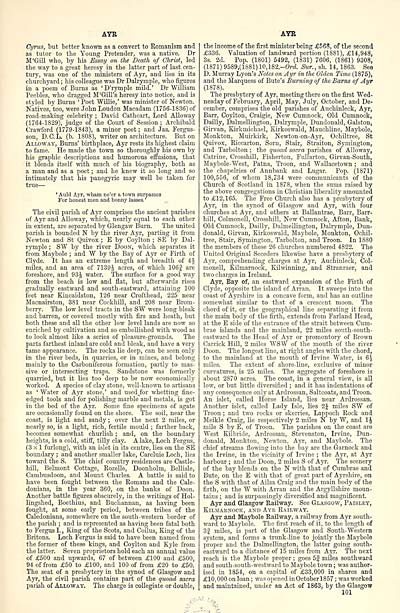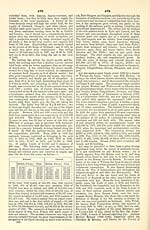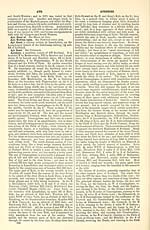Ordnance gazetteer of Scotland > Volume 1
(133) Page 101
Download files
Complete book:
Individual page:
Thumbnail gallery: Grid view | List view

AYR
Cyrus, but better known as a convert to Romanism and
as tutor to the Young Pretender, was a native. Dr
M'Gill who, by his Essay on the Death of Christ, led
the way to a great heresy in the latter part of last cen-
tury, was one of the ministers of Ayr, and lies in its
churchyard ; his colleague was Dr Dalrymple, who figures
in a poem of Burns as 'D'rymple mild.' Dr William
Peebles, who dragged M'GiU's heresy into notice, and is
styled by Burns ' Poet Willie,' was minister of Newton.
Natives, too, were John Loudon Macadam (1756-1836) of
road-making celebrity ; David Cathcart, Lord Alloway
(1764-1829), judge of the Court of Session ; Archibald
Crawford (1779-1843), a minor poet ; and Jas. Fergus-
son, D.C.L. (b. 1808), writer on architecture. But on
Alloway, Burns' birthplace, Ayr rests its highest claim
to fame. He made the town so thoroughly his own by
his graphic descriptions and humorous effusions, that
it blends itself with much of his biography, both as
a man and as a poet ; and he knew it so long and so
intimately that his panegyric may well be taken for
true —
' Auld Ayr, wham ne'er a town surpasses
For honest men and bonny lasses.'
The civil parish of Ayr comprises the ancient parishes
of Ayr and Alloway, which, nearly equal to each other
in extent, are separated by Glengaw Burn. The united
parish is bounded N by the river Ayr, parting it from
Newton and St Quivox ; E by Coylton ; SE by Dal-
rymple ; SW by the river Doon, which separates it
from Maybole ; and W by the Bay of Ayr or Firth of
Clyde. It has an extreme length and breadth of 4J
miles, and an area of 7139J acres, of which 106J are
foreshore, and 93J water. The surface for a good way
from the beach is low and flat, but afterwards rises
gradually eastward and south-eastward, attaining 100
feet near Kincaidston, 126 near Crofthead, 225 near
Macnairston, 381 near Cockhill, and 208 near Brom-
berry. The low level tracts in the SW were long bleak
and barren, or covered mostly with firs and heath, but
both these and all the other low level lands are now so
enriched by cultivation and so embellished with wood as
to look almost like a series of pleasure-grounds. The
parts farthest inland are cold and bleak, and have a very
tame appearance. The rocks lie deep, can be seen only
in the river beds, in quarries, or in mines, and belong
mainly to the Carboniferous formation, partly to mas-
sive or intersecting traps. Sandstone was formerly
quarried, but it lies too deep to be now economical^
worked. A species of clay stone, well-known to artisans
as ' Water of Ayr stone,' and used Jo r whetting fine-
edged tools and for polishing marble and metals, is got
in the bed of the Ayr. Some fine specimens of agate
are occasionally found on the shore. The soil, near the
coast, is light and sandy ; over the next 2 miles, or
nearly so, is a light, rich, fertile mould ; farther back,
becomes somewhat churlish ; and, on the boundary
heights, is a cold, stiff, tilly clay. A lake, Loch Fergus,
(3x1 furlong), with an islet in its centre, lies on the SE
boundary ; and another smaller lake, Carcluie Loch, lies
toward the S. The chief country residences are Castle-
hill, Belmont Cottage, Rozelle, Doonholm, Bellisle,
Cambusdoon, and Mount Charles. A battle is said to
have been fought between the Romans and the Cale-
donians, in the year 360, on the banks of Doon.
Another battle figures obscurely, in the writings of Hol-
lingshed, Boethius, and Buchannan, as having been
fought, at some early period, between tribes of the
Caledonians, somewhere on the south-western border of
the parish ; and is represented as having been fatal both
to Fergus I. , King of the Scots, and Coilus, King of the
Britons. Loch Fergus is said to have been named from
the former of these kings, and Coylton and Kyle from
the latter. Seven proprietors hold each an annual value
of £500 and upwards, 67 of between £100 and £500,
94 of from £50 to £100, and 100 of from £20 to £50.
The seat of a presbytery in the synod of Glasgow and
Ayr, the civil parish contains part of the quoad sacra
parish of Alloway. The charge is collegiate or double,
!
AYR
the income of the first minister being £568, of the second
£336. Valuation of landward portion (1881), £14,948,
3s. 2d. Pop. (1801) 5492, (1831) 7606, (1861) 9308,
(1871) 9589,(1881) 10,182.~Ord. Sur., sh. 14, 1863. Sea
D. Murray Lyon's Notes on Ayr in the Olden Time (1875),
and the Marquess of Bute's Burning of the Barns of Ayr
(1S78).
The presbytery of Ayr, meeting there on the first Wed-
nesday of February, April, May, July, October, and De-
cember, comprises the old parishes of Auchinleck, Ayr,
Barr, Coylton, Craigie, New Cumnock, Old Cumnock,
Dailly, Dalmellington, Dalrymple, Dundonald, Galston,
Girvan, Kirkmichael, Kirkoswald, Mauchline, Maybole,
Monkton, Muirkirk, Newton-on-Ayr, Ochiltree, St
Quivox, Riccarton, Sorn, Stair, Straiton, Symington,
and Tarbolton ; the quoad saera parishes of Alloway,
Catrine, Crosshill, Fisherton, Fullarton, Girvan-South,
Maybole-West, Patna, Troon, and Wallacetown ; and
the chapelries of Annbank and Lugar. Pop. (1871)
100,556, of whom 18,734 were communicants of the
Church of Scotland in 1878, when the sums raised by
the above congregations in Christian liberality amounted
to £12,165. The Free Church also has a presbytery of
Ayr, in the synod of Glasgow and Ayr, with four
churches at Ayr, and others at Ballantrae, Barr, Barr-
hill, Colmonell, Crosshill, New Cumnock, Afton, Bank,
Old Cumnock, Dailly, Dalmellington, Dalrymple, Dun-
donald, Girvan, Kirkoswald, Maybole, Monkton, Ochil-
tree, Stair, Symington, Tarbolton, and Troon. In 1880
the members of these 26 churches numbered 4822. The
United Original Seceders likewise have a presbytery of
Ayr, comprehending charges at Ayr, Auchinleck, Col-
monell, Kilmarnock, Kilwinning, and Stranraer, and
two charges in Ireland.
Ayr, Bay of, an eastward expansion of the Firth of
Clyde, opposite the island of Arran. It sweeps into the
coast of Ayrshire in a concave form, and has an outline
somewhat similar to that of a crescent moon. The
chord of it, or the geographical line separating it from
the main body of the firth, extends from Farland Head,
at the E side of the entrance of the strait between Cum-
brae islands and the mainland, 22 miles south-south-
eastward to the Head of Ayr or promontory of Brown
Carrick Hill, 2 miles WSW of the mouth of the river
Doon. The longest line, at right angles with the chord,
to the mainland at the mouth of Irvine Water, is 64
miles. The extent of shore-line, exclusive of minor
curvatures, is 25 miles. The aggregate of foreshore is
about 2870 acres. The coast, in a general view, is all
low, or but little diversified ; and it has indentations of
any consequence only at Ardrossan, Saltcoats, and Troon.
An islet, called Horse Island, lies near Ardrossan.
Another islet, called Lady Isle, lies 2J miles SW of
Troon ; and two rocks or skerries, Lappoch Rock and
Meikle Craig, lie respectively 2 miles N by W, and 1£
mile S by E, of Troon. The parishes on the coast are
West Kilbride, Ardrossan, Stevenston, Irvine, Dun-
donald, Monkton, Newton, Ayr, and Maybole. The
chief streams flowing into the bay are the Garnock and
the Irvine, in the vicinity of Irvine ; the Ayr, at Ayr
harbour ; and the Doon, 2 miles S of Ayr. The scenery
of the bay blends on the N with that of Cumbrae and
Bute, on the E with that of great part of Ayrshire, on
the S with that of Ailsa Craig and the main body of the
firth, on the W with Arran and the Argyllshire moun-
tains ; and is surpassingly diversified and magnificent.
Ayr and Glasgow Railway. See Glasgow, Paisley,
Kilmarnock, and Ayr Railway.
Ayr and Maybole Railway, a railway from Ayr south-
ward to Maybole. The first reach of it, to the length of
3J miles, is part of the Glasgow and South-Western
system, and forms a trunk-line to jointly the Maybole
proper and the Dalmellington, the latter going south-
eastward to a distance of 15 miles from Ayr. The next
reach is the Maybole proper ; goes 5| miles southward
and south-south-westward to Maybole town; was author-
ised in 1854, on a capital of £33,000 in shares and
£10,000 on loan; was opened in Octoberl857 ; was worked
and maintained, under an Act of 1863, by the Glasgow
101
Cyrus, but better known as a convert to Romanism and
as tutor to the Young Pretender, was a native. Dr
M'Gill who, by his Essay on the Death of Christ, led
the way to a great heresy in the latter part of last cen-
tury, was one of the ministers of Ayr, and lies in its
churchyard ; his colleague was Dr Dalrymple, who figures
in a poem of Burns as 'D'rymple mild.' Dr William
Peebles, who dragged M'GiU's heresy into notice, and is
styled by Burns ' Poet Willie,' was minister of Newton.
Natives, too, were John Loudon Macadam (1756-1836) of
road-making celebrity ; David Cathcart, Lord Alloway
(1764-1829), judge of the Court of Session ; Archibald
Crawford (1779-1843), a minor poet ; and Jas. Fergus-
son, D.C.L. (b. 1808), writer on architecture. But on
Alloway, Burns' birthplace, Ayr rests its highest claim
to fame. He made the town so thoroughly his own by
his graphic descriptions and humorous effusions, that
it blends itself with much of his biography, both as
a man and as a poet ; and he knew it so long and so
intimately that his panegyric may well be taken for
true —
' Auld Ayr, wham ne'er a town surpasses
For honest men and bonny lasses.'
The civil parish of Ayr comprises the ancient parishes
of Ayr and Alloway, which, nearly equal to each other
in extent, are separated by Glengaw Burn. The united
parish is bounded N by the river Ayr, parting it from
Newton and St Quivox ; E by Coylton ; SE by Dal-
rymple ; SW by the river Doon, which separates it
from Maybole ; and W by the Bay of Ayr or Firth of
Clyde. It has an extreme length and breadth of 4J
miles, and an area of 7139J acres, of which 106J are
foreshore, and 93J water. The surface for a good way
from the beach is low and flat, but afterwards rises
gradually eastward and south-eastward, attaining 100
feet near Kincaidston, 126 near Crofthead, 225 near
Macnairston, 381 near Cockhill, and 208 near Brom-
berry. The low level tracts in the SW were long bleak
and barren, or covered mostly with firs and heath, but
both these and all the other low level lands are now so
enriched by cultivation and so embellished with wood as
to look almost like a series of pleasure-grounds. The
parts farthest inland are cold and bleak, and have a very
tame appearance. The rocks lie deep, can be seen only
in the river beds, in quarries, or in mines, and belong
mainly to the Carboniferous formation, partly to mas-
sive or intersecting traps. Sandstone was formerly
quarried, but it lies too deep to be now economical^
worked. A species of clay stone, well-known to artisans
as ' Water of Ayr stone,' and used Jo r whetting fine-
edged tools and for polishing marble and metals, is got
in the bed of the Ayr. Some fine specimens of agate
are occasionally found on the shore. The soil, near the
coast, is light and sandy ; over the next 2 miles, or
nearly so, is a light, rich, fertile mould ; farther back,
becomes somewhat churlish ; and, on the boundary
heights, is a cold, stiff, tilly clay. A lake, Loch Fergus,
(3x1 furlong), with an islet in its centre, lies on the SE
boundary ; and another smaller lake, Carcluie Loch, lies
toward the S. The chief country residences are Castle-
hill, Belmont Cottage, Rozelle, Doonholm, Bellisle,
Cambusdoon, and Mount Charles. A battle is said to
have been fought between the Romans and the Cale-
donians, in the year 360, on the banks of Doon.
Another battle figures obscurely, in the writings of Hol-
lingshed, Boethius, and Buchannan, as having been
fought, at some early period, between tribes of the
Caledonians, somewhere on the south-western border of
the parish ; and is represented as having been fatal both
to Fergus I. , King of the Scots, and Coilus, King of the
Britons. Loch Fergus is said to have been named from
the former of these kings, and Coylton and Kyle from
the latter. Seven proprietors hold each an annual value
of £500 and upwards, 67 of between £100 and £500,
94 of from £50 to £100, and 100 of from £20 to £50.
The seat of a presbytery in the synod of Glasgow and
Ayr, the civil parish contains part of the quoad sacra
parish of Alloway. The charge is collegiate or double,
!
AYR
the income of the first minister being £568, of the second
£336. Valuation of landward portion (1881), £14,948,
3s. 2d. Pop. (1801) 5492, (1831) 7606, (1861) 9308,
(1871) 9589,(1881) 10,182.~Ord. Sur., sh. 14, 1863. Sea
D. Murray Lyon's Notes on Ayr in the Olden Time (1875),
and the Marquess of Bute's Burning of the Barns of Ayr
(1S78).
The presbytery of Ayr, meeting there on the first Wed-
nesday of February, April, May, July, October, and De-
cember, comprises the old parishes of Auchinleck, Ayr,
Barr, Coylton, Craigie, New Cumnock, Old Cumnock,
Dailly, Dalmellington, Dalrymple, Dundonald, Galston,
Girvan, Kirkmichael, Kirkoswald, Mauchline, Maybole,
Monkton, Muirkirk, Newton-on-Ayr, Ochiltree, St
Quivox, Riccarton, Sorn, Stair, Straiton, Symington,
and Tarbolton ; the quoad saera parishes of Alloway,
Catrine, Crosshill, Fisherton, Fullarton, Girvan-South,
Maybole-West, Patna, Troon, and Wallacetown ; and
the chapelries of Annbank and Lugar. Pop. (1871)
100,556, of whom 18,734 were communicants of the
Church of Scotland in 1878, when the sums raised by
the above congregations in Christian liberality amounted
to £12,165. The Free Church also has a presbytery of
Ayr, in the synod of Glasgow and Ayr, with four
churches at Ayr, and others at Ballantrae, Barr, Barr-
hill, Colmonell, Crosshill, New Cumnock, Afton, Bank,
Old Cumnock, Dailly, Dalmellington, Dalrymple, Dun-
donald, Girvan, Kirkoswald, Maybole, Monkton, Ochil-
tree, Stair, Symington, Tarbolton, and Troon. In 1880
the members of these 26 churches numbered 4822. The
United Original Seceders likewise have a presbytery of
Ayr, comprehending charges at Ayr, Auchinleck, Col-
monell, Kilmarnock, Kilwinning, and Stranraer, and
two charges in Ireland.
Ayr, Bay of, an eastward expansion of the Firth of
Clyde, opposite the island of Arran. It sweeps into the
coast of Ayrshire in a concave form, and has an outline
somewhat similar to that of a crescent moon. The
chord of it, or the geographical line separating it from
the main body of the firth, extends from Farland Head,
at the E side of the entrance of the strait between Cum-
brae islands and the mainland, 22 miles south-south-
eastward to the Head of Ayr or promontory of Brown
Carrick Hill, 2 miles WSW of the mouth of the river
Doon. The longest line, at right angles with the chord,
to the mainland at the mouth of Irvine Water, is 64
miles. The extent of shore-line, exclusive of minor
curvatures, is 25 miles. The aggregate of foreshore is
about 2870 acres. The coast, in a general view, is all
low, or but little diversified ; and it has indentations of
any consequence only at Ardrossan, Saltcoats, and Troon.
An islet, called Horse Island, lies near Ardrossan.
Another islet, called Lady Isle, lies 2J miles SW of
Troon ; and two rocks or skerries, Lappoch Rock and
Meikle Craig, lie respectively 2 miles N by W, and 1£
mile S by E, of Troon. The parishes on the coast are
West Kilbride, Ardrossan, Stevenston, Irvine, Dun-
donald, Monkton, Newton, Ayr, and Maybole. The
chief streams flowing into the bay are the Garnock and
the Irvine, in the vicinity of Irvine ; the Ayr, at Ayr
harbour ; and the Doon, 2 miles S of Ayr. The scenery
of the bay blends on the N with that of Cumbrae and
Bute, on the E with that of great part of Ayrshire, on
the S with that of Ailsa Craig and the main body of the
firth, on the W with Arran and the Argyllshire moun-
tains ; and is surpassingly diversified and magnificent.
Ayr and Glasgow Railway. See Glasgow, Paisley,
Kilmarnock, and Ayr Railway.
Ayr and Maybole Railway, a railway from Ayr south-
ward to Maybole. The first reach of it, to the length of
3J miles, is part of the Glasgow and South-Western
system, and forms a trunk-line to jointly the Maybole
proper and the Dalmellington, the latter going south-
eastward to a distance of 15 miles from Ayr. The next
reach is the Maybole proper ; goes 5| miles southward
and south-south-westward to Maybole town; was author-
ised in 1854, on a capital of £33,000 in shares and
£10,000 on loan; was opened in Octoberl857 ; was worked
and maintained, under an Act of 1863, by the Glasgow
101
Set display mode to: Large image | Transcription
Images and transcriptions on this page, including medium image downloads, may be used under the Creative Commons Attribution 4.0 International Licence unless otherwise stated. ![]()
| Gazetteers of Scotland, 1803-1901 > Ordnance gazetteer of Scotland > Volume 1 > (133) Page 101 |
|---|
| Permanent URL | https://digital.nls.uk/97370362 |
|---|
| Attribution and copyright: |
|
|---|---|

